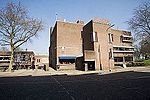Velorama
1981 establishments in the NetherlandsBicycle museumsCycling in NijmegenDutch building and structure stubsEuropean museum stubs ... and 3 more
Museums established in 1981Museums in NijmegenTransport museums in the Netherlands

The Velorama (Dutch: Nationaal fietsmuseum Velorama) is the only bicycle museum in the Netherlands. It is located at the Waalkade in the city of Nijmegen. The museum was founded in 1981 from the private collection of G.F. Moed. In three storeys it shows about 250 exhibits from nearly two centuries. The Velorama owns a large collection of bicycle literature and also preserves the historic archive of the Dutch bicycle manufacturer Gazelle.
Excerpt from the Wikipedia article Velorama (License: CC BY-SA 3.0, Authors, Images).Velorama
Lindenberghaven, Nijmegen Nijmegen-Centrum (Nijmegen)
Geographical coordinates (GPS) Address Website Nearby Places Show on map
Geographical coordinates (GPS)
| Latitude | Longitude |
|---|---|
| N 51.848888888889 ° | E 5.8697222222222 ° |
Address
Lindenberghaven
Lindenberghaven
6511 XR Nijmegen, Nijmegen-Centrum (Nijmegen)
Gelderland, Netherlands
Open on Google Maps










